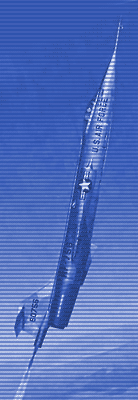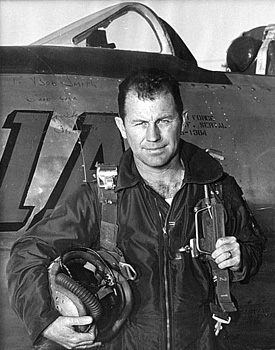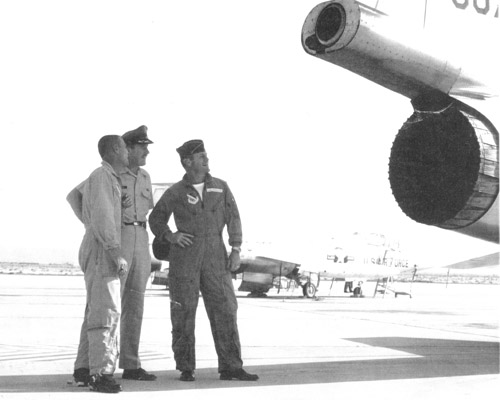The Mission > home

|
|
|
|
|
|
 |
The Mission click on the links below for more of the story...
|
||||
11 Unwanted Record for Chuck Yeager
After Chuck Yeager took command of ARPS, a few months before I graduated, we didn’t see him except for the brief period we were together on the graduation trip for our class with him and Gen. Twig Branch and hospital commander Col. Stan Bear to Europe. I can tell you this, when you traveled with Chuck Yeager anywhere, he received attention. In the subsequent year I don’t think I ever encountered Chuck, until after Pete had briefed me on the decision by headquarters. In preparation for his AST project, I briefed him every chance he gave me, went over the airplane with him and discussed procedures and the flight profiles. I briefed him on the specifics of the mission before every flight he made. I detailed everything I knew about the airplane and handling it, especially the differences between the RCS and aerodynamic control, but often I got the message that he didn’t need all of that, he had experience to call upon. He was not demeaning or curt, just matter of fact and very confident. Over the years I have seen a lot of Jeckyl and a little Hyde in Chuck, when he has greeted me as an old buddy, an unknown or disdainfully, reasons unknown, or just circumstance. But during this period our relationship was very cordial, so much so that Jackie Cochran, and her powerful husband, invited Martha and me to a private party followed by the Wright Memorial Dinner in Los Angeles. Jackie adored Chuck and I was being rewarded for assisting him. The Big Four were all at that party, including Chief of Staff, General LeMay. The event was very special to Martha, because her personal dinner partner was Dr. Edward Teller, father of the atom bomb. At the party, Mrs. Lemay introduced me to her husband, mistakenly by higher rank. When I politely revised that, she asked why he didn’t promote me, to which he sourly replied, “If I did I’d have to pay him!” and promptly walked away, without an inkling of a smile. After my previous introduction in his office as one of the Air Force finalists for the NASA Gemini program, I had still never seen him smile, which some attributed to a disease of facial nerves. I can say, as many have, he was somewhat unnerving. As Chuck started flying the zoom missions, I went over his ground station plots after each mission with him. Those gave no indications about techniques or attitude of the airplane, being limited to a ground plot, but showed climb angle and ground track, which was all I’d ever had available. Chucks plots showed that he never would complete the initial pull up to the necessary angle of 70 degrees when he was trying to get maximum zoom and he barely got over 100,000 feet on any mission. The early part of a climb was especially critical because the speed was very high and rapidly lost in drag at low angle versus conversion to altitude at the proper steep climb angle. If the angle were not achieved at the outset but was raised to correct it later the loss of energy was great. The plots showed he was doing just that, which I brought to his attention before each flight.
In addition, I tried repeatedly to get him to sit still long enough to listen to the difference between handling the AST as an airplane and the way it would be when he flew over the top of a max zoom. He was in no way disparaging me, but he just seemed confident that he had experienced everything airplanes could do, and the briefings would end. I just don’t think he conceived that there was anything in an airplane that he had not already done and he was right. He had implicit feel for flight in an airplane, no doubt, but he wouldn’t perceive the concept of flight except in the atmosphere. The AST would soon stop being an airplane for him. I repeatedly tried to convince him, and hoped that his repeated failures to exceed about 100,000 to 105,000 feet would get his attention, but it never did. Chuck reminded me of the racecar drivers of long ago versus today’s drivers. The old ones just felt it and drove it. The great current drivers help to establish the design, understand the technology and why the car handles like it does and grow with changes. Some of the best are engineering graduates. Chuck had the same results on the morning of December 10th, before his fateful afternoon flight and we talked about the profile and problems again. I remember telling him with certainty that he would never beat the record if he didn’t hold the 3.5 g’s right up to 70 degrees and damned sure hold the climb angle until intercepting the 16-degree angle of attack. In a sense, pitch attitude control display was very familiar, because it was used with the RCS controller like an ILS approach with the stick. But the down side was that the airplanes RCS responses were nothing like the response of the control stick. That was not possible, because it was space dynamics and control versus flying an airplane. The AST zoom was 100% on instruments, but I assumed Chuck was skilled in that, although instrument training was sparse and crude in his WW II era training. It was very easy to let off the stick pressure and reduce the 3.5 g during pull-up or later allow the climb angle to decrease and once decreased it could not be corrected without serious loss of energy and possible adverse consequences. There was no second chance on any of the objectives. I repeated each briefing that it could only be those mistakes that were costing him altitude. I emphasized, the airplane was perfectly well equipped to display the information necessary to fly the mission and with sufficient margin to safely do so as long as he did not vary greatly from the profile, exceeding the limits of the display. There were many, many things necessary to a safe and successful flight, distractions, switches and controls to be attended to, continually monitoring critical engine and rocket gages, constantly retarding and finally shutting down afterburner and then main jet exactly at their limits for maximum performance with safety. Some of that might be sacrificed during the zoom, if necessary, to give critical attention to the primary task of controlling the flight path and converting from aerodynamic controls to the RCS as the atmosphere gave way to space, but all was important. And then attending to the most critical of all, controlling proper attitude throughout the 140 degrees of nose-over, and finally, the reentry retaining the 16 degree alpha until safely in aerodynamic descent. I saw no progress in Chuck’s results. I was concerned, but I knew that there was nothing more I could do than repeat and hope he would finally accept the message, or somehow find it with his almost magical ability to fly. I don’t believe he ever bought the concept that the AST would not control like any airplane he ever flew or heeded my description of the differences necessary for controlling it. |
| previous section | next section |

